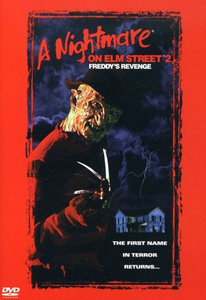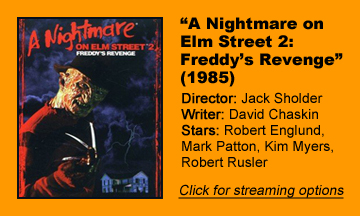From Sept. 18-Oct. 16, we’re looking back at the nine films of the “Nightmare on Elm Street” franchise. Next up is the second film, “A Nightmare on Elm Street 2: Freddy’s Revenge” (1985):
Not bad for being cranked out
For a sequel cranked out for release less than a year after its predecessor, “A Nightmare on Elm Street 2: Freddy’s Revenge” ain’t half bad.
With the Freddy mythology and dreamscape rules established, writer David Chaskin and director Jack Sholder give us a decent amount of new things as Jesse (Mark Patton) moves into the house of Nancy (Heather Langenkamp, not returning for this one) five years later.
That means this movie is set in 1989, technically, although its 1985-ness is a big part of the appeal. Jesse listens to Simple Minds on cassette and has 1985 Topps baseball cards on his desk.
The hairstyles, fashions, swimsuits at the pool party, and Jesse’s dad’s (Clu Gulager) worries about drugs come straight from the heart of the 1980s.
So by moving it ahead to the near future, “Freddy’s Revenge” isn’t exactly being progressive; it’s merely being sloppy about the timeline (something also characteristic of the “Friday the 13th” movies). I guess the idea is to move Nancy’s experiences with Freddy (Robert Englund) more into the realm of ancient history than current events.
Chaskin gets to the “lead character is influenced by the killer” part of the saga much quicker than “Friday the 13th” (the fourth entry, in 1984) or “Halloween” (also the fourth entry, in 1988) do — and more bluntly, as Jesse is possessed by Freddy.
A rare Final Guy
But the film is kind of progressive in using a Final Guy (slashers using “Final Girls” was a given by this point) and by arguably making him a “coded” closeted gay character.
When analyzing films from before the recent age when gay storylines aren’t considered a box-office death knell, scholars look for the way the literal events are a thinly veiled cover for what the filmmakers want to say.
Code theory can arguably be taken too far – for example, some say Jack-Rose in “Titanic” is a coded gay romance – but it fits with this film. I had noticed Shudder has a documentary on the gay subtext of “Freddy’s Revenge,” but even without that, it’s hard not to notice that Sholder lingers on the shirtless and sweaty Jesse when he wakes from a nightmare more than once.
Meanwhile, although the film includes bikini-clad girls at the pool party, the camera doesn’t linger on them like you might expect.
Different possible readings
One of Jesse’s nightmares finds him being ordered to run laps by his gym teacher (Marshall Bell as Coach Schneider). That’s followed by the inevitable “hit the showers,” and here Jesse/Freddy slaps the bare ass of Schneider – rumored to be gay among the student populace — with a towel before killing him.
Freddy is literally Jesse’s repressed dark side, but perhaps metaphorically is his repressed sexual orientation. Throw in the fairly mainstream demonization of gay people in 1985, and it’s up to a viewer to decide if Jesse’s closeted gayness makes him sympathetic or in need of counseling. But I suspect the filmmakers, at least, are sympathetic toward him.
Once you go down this rabbit hole, you notice more things that fit the theory. In the opening dream sequence, Jesse is on a bus with two girls who are whispering about him and laughing.
My interpretation is that he lacks confidence around girls. But in the waking world, we see he projects confidence and has a loyal girlfriend, Kim Myers’ Lisa. The coded narrative, though, allows that sequence to click better.
Strong cast of unknowns
For a film with no breakout stars, the cast is solid. Patton looks like a future star just as much as Johnny Depp in the original film, evoking confidence until the point where Freddy gets hold of him. And Myers looks like Meryl Streep.
The actors portray a strikingly mature relationship for teenagers, with many conversations about what’s happening in their lives and hardly any where Jesse awkwardly wants to have sex with her.
In fact, Jesse runs off amid a makeout session with Lisa – literally because Freddy is possessing him and he wants to protect her, and because of his sexual orientation in the coded reading. It plays well whether they are unusually mature teen lovers or playing out a coded story wherein the girl gradually accepts that the guy is gay and remains his friend.
A corny charm
“Freddy’s Revenge” looks good for a cranked-out film, with its Springsteenian abandoned factory that contains the boiler room where Freddy was burned to death by Elm Street parents, as referenced in the first film.
The visual effects have a corny charm to them, and there are smart touches such as the heat in Jesse’s house (his dad resists the idea that the A/C doesn’t work) and the pool turning into a sauna during the party.
There are some stupid things too, like an exploding pet bird. And the pacing could be tighter. I’m not saying “Freddy’s Revenge” will stick in your brain for long.
Indeed, it’s not scary — there’s an inherent goofiness to the “Nightmare” films that prevents that, even though the portrayals of the weirdness of dreams are good.
But it does think outside the box and give us some new talking points, and that puts it a cut above the genre average.
Click here to visit our Horror Zone.

“A Nightmare on Elm Street” series reviews
Friday, Sept. 18: “A Nightmare on Elm Street” (1984)
Wednesday, Sept. 23: “A Nightmare on Elm Street 2: Freddy’s Revenge” (1985)
Friday, Sept. 25: “A Nightmare on Elm Street 3: Dream Warriors” (1987)
Wednesday, Sept. 30: “A Nightmare on Elm Street 4: The Dream Master” (1988)
Friday, Oct. 2: “A Nightmare on Elm Street 5: The Dream Child” (1989)
Wednesday, Oct. 7: “Freddy’s Dead: The Final Nightmare” (1991)
Friday, Oct. 9: “Wes Craven’s New Nightmare” (1994)
Wednesday, Oct. 14: “Freddy vs. Jason” (2003)
Friday, Oct. 16: “A Nightmare on Elm Street” (2010)



